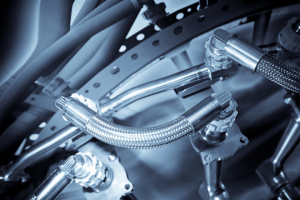
Problems caused by external hydraulic leaks can be costly and time consuming to resolve. By understanding how to diagnose and resolve these issues, you can help keep your system running smoothly and prevent unexpected downtime.
Causes Of External Hydraulic Leaks
External hydraulic leaks often occur when there is an issue with the hose or fittings in a hydraulic system. In order to identify and resolve these external hydraulic leaks, you should first inspect all of the hoses and connections to determine if they are loose or missing. A visual inspection will often help you find any damage that may be causing the leak, such as cracks, holes, or corrosion.
Once you have identified the cause of the leak, it is important to address it immediately. You should replace worn or damaged hoses and fittings with new parts and tighten all connections securely. Replacing seals and O-rings at regular intervals can also help reduce the risk of external leaks.
Professional Diagnosis And Support
However, if the problem persists after inspecting your hoses and fittings, you may need to power down the system to inspect your individual hydraulic system components. Components to give close attention to include the pump, valves, reservoir, accumulators, and other components that are used to control fluid flow.
If any of these parts are worn or damaged, they should be replaced or repaired as soon as possible. An experienced hydraulic technician will be able to inspect and diagnose the problem as well as provide recommendations on the best way of resolving it.
Why It Is Important To Quickly Identify And Resolve Hydraulic Leaks
When hydraulic fluid leaks, it not only leads to wasted resources from lost fluid but can also lead to other serious consequences for your business and the wider environment. For example, the loss of pressurised fluid can cause overheating of the fluid power system due to lack of cooling, leading to further damage or even a fire. Environmental damage may also arise if the leaked fluid enters water sources such as rivers or other bodies of water, potentially contaminating them with dangerous chemicals. System contamination can also occur if the leaked fluid mixes with dirt and dust particles, causing blockages in the system which can lead to further damage. All of these consequences can be detrimental to your fluid power equipment and your operational productivity as a whole.
Hydraulic Maintenance Best Practices
In order to correctly diagnose the issues that result in external leaks, it is important to understand the root cause of the failure. This can be done by maintaining good operational and maintenance records and noting the age of the failed part or parts against your manufacturer’s specifications. If the seal or connection fails before its expected end-of-life, for instance, there may be an additional factor causing it to degrade more quickly.
Troubleshooting Support From Hydrastar
To ensure maximum machine life and system efficiency, it is important to identify the underlying cause of leaks and select the most suitable replacement parts. If needed, our team of experienced hydraulic technicians at Hydrastar can provide you with assistance with troubleshooting. Please call today to find out more.
Image Source: Canva

